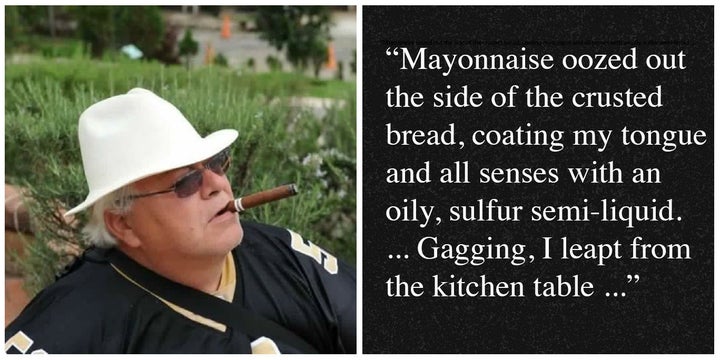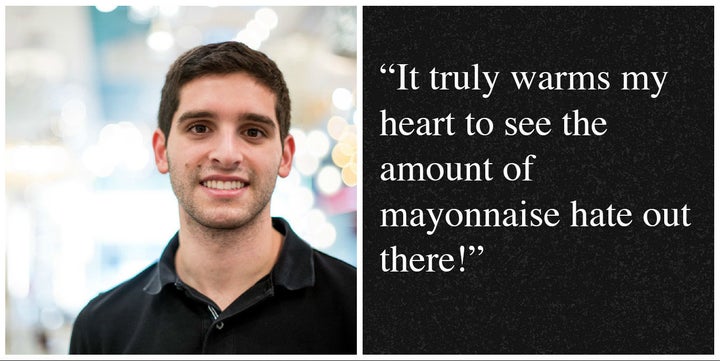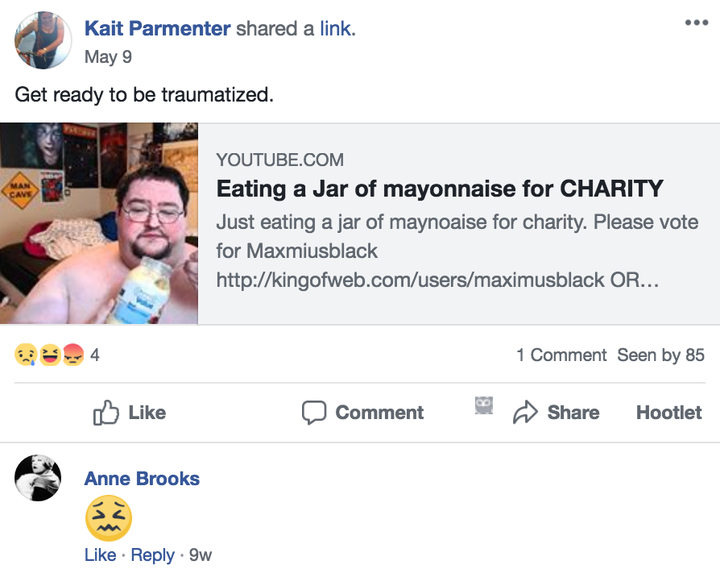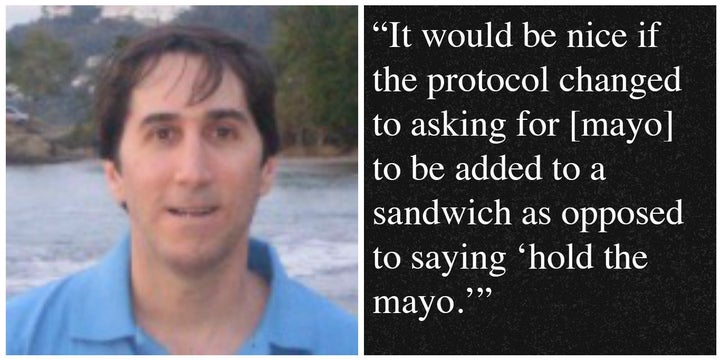
Victor Lachin, an electrical engineer living in southern Mississippi, vividly recalls the first time he tried mayonnaise as a child.
The year was 1966, and he was having lunch at a friend’s house in the Lakefront area of New Orleans. The friend had “a ham sandwich with white Bunny Bread, slathered with Blue Plate mayonnaise,” he tells me over Facebook Messenger. “Asking me what I would like, I responded ‘Peanut butter sandwich, ma’am!’ She complied with a nice Bunny Bread sandwich and a glass of cold white milk.”
Lachin bit into the sandwich, expecting a creamy, nutty taste to fill his mouth. Instead, “Mayonnaise oozed out the side of the crusted bread, coating my tongue and all senses with an oily, sulfur semi-liquid. ... Gagging, I leapt from the kitchen table as her hate-filled babbling told me to never come back again. I remember the sound of a worn corn broom chasing my bare feet out the back door. I climbed the fence to get home.” He was 5 or 6 years old, he reckons.

It’s a memory that’s stayed with him his entire life. He described a similarly traumatic experience while attending a Catholic school summer camp. In a post from 2011, found within the I Hate Mayonnaise! Facebook group, it involved receiving the wrong lunch from his mother (a sandwich slathered in mayo) and a nun who forced him to eat it.
Of all the condiments out there, a fierce hostility toward mayonnaise is definitely the most prevalent. It’s one of the most divisive foods, on par with cilantro, blue cheese and coconut. But the hatred for what is essentially emulsified egg yolks, oil and some kind of acid (typically lemon juice, or vinegar) goes beyond the polite declining of a tuna sandwich: It’s a force that bonds people, either as a comfort or, in some cases, a means to control public mayonnaise options.
In recent years, the internet has done a lot for self-identifying mayo haters to feel connected. Facebook groups, anti-mayonnaise Facebook pages, Reddit forums and other online community hubs provide them with an arena where they can air their grievances against the spread. Journalists against mayonnaise have published their views nationally. Non-Mayo-Eaters can even proudly express their views via fashion as well.
While most people can trace their mayo hatred back to a specific point when they first tasted it and immediately disliked it, there is actually a science to why it’s so repulsive for some. Most of it has to do with sensory issues: How it looks, its consistency, even its temperature (room-temperature goo, no thanks) all contribute to an avoidance of mayo at all costs.
However, it’s still one of those foods that feels almost phobia-like.
“I don’t know why I hate mayo,” Damara Hutchins, a registered nurse from Florida, tells me. “I have looked at the individual ingredients and can find no reason I despise it so much.”
Hutchins goes to great lengths to avoid even the smallest trace of mayonnaise. She’ll grill people about “suspicious items,” and avoids most salad dressing (olive oil alone is perfectly fine). Sandwiches are topped with mustard. She only uses ketchup on fries and burgers.
It’s her Southern roots, however, that give her the most trouble. Duke’s mayonnaise, a recipe developed by Eugenia Duke during World War I, is a staple of Southern cooking.

“Mayo is like pudding,” Hutchins said in a message, discussing the added pressure of dealing with family members who don’t understand her distaste for mayo. “They use it for deviled eggs, potato salad and fruit salad.”
Her father used to eat banana sandwiches slathered in mayo and “dip his fries in mayo mixed with ketchup.”
Her senses heightened for the taste of mayo as she grew older; one of her stories involved tasting mayonnaise in a batch of biscuits her grandmother made. The recipe called for one tablespoon of the stuff.
Both Lachin and Hutchins are part of the Facebook group I Hate Mayonnaise! It was founded in 2015 by a group of friends who hated mayo.
“I started this group a couple of years ago to see the amount of fellow mayonnaise haters,” Gabe Golan, the group’s main moderator, tells me. “I was surprised to see the response. It truly warms my heart to see the amount of mayonnaise hate out there!” The group has only 132 members, but they are very active and post a few times a month.
“Gabe and I were at an event talking about our disgust for mayo,” said Catherine DeLauro, a friend of Gabe’s and another administrator for the group. “After a few beers, we decided to make the FB group.”
Her boyfriend, who was also part of the conversation, created his own (now defunct) Pro-Mayo group. “They are my arch nemesis,” DeLauro added.
The group has now become a forum for those united under the commonality, and it was featured in a BuzzFeed article in 2016. Members post memes and videos, articles or images of “mayo issues” (one post featured a chocolate cake step-by-step video, with the caption, “Who on earth decided to put Mayonnaise in cake?”). Members ask for cooking tips and generally commiserate over their hatred for mayo and how it affects their lives.
When asked why they hate mayonnaise so much, group members were quick to reply:
“It looks like pus.”
“The smell gives me migraines, and makes me want to gag.”
“Most things in nature white in appearance that are not vegetables are rotten and disgusting. Sea Foam is white in color. Would you put sea foam on your lunch?”

The Facebook group has proved to be enough for some, but others have taken more drastic measures in an effort to show the world how awful mayonnaise is.
Charles Memminger, a former columnist for the Honolulu Star-Bulletin, practically made a career out of vehement articles against the condiment. In the 1980s, he created the Worldwide I Hate Mayonnaise Club: “This was before the internet, so I had to mail out everything. ... For 10 bucks, I’d send members the official certificate, a ‘Just Say No Mayo’ number sticker and a decal.” Eventually, people were able to download a certificate that denoted their membership. His website, nomayo.com, is no longer active, but his work has clearly inspired others. “A Hawaii senator gave President Obama a copy of the certificate, which made him an official member of the club. To this day I still consider President Obama one of the few U.S. presidents with good taste!”
Craig Horwitz, a marketing manager from Lafayette Hill, Pennsylvania, has also made it his life’s campaign to control the condiment he claims “has terrorized so many people around the world.” In 2014, along with fellow mayo-hater Tony Vollmer, he co-wrote, directed and produced a 64-minute film, The Mayo Conspiracy. “While researching deeper into the mayonnaise industry, I started uncovering explosive information that was just way too big for my blog,” Horwitz told me over email.
His research into what he calls “Big Mayo” — Hellman’s, Best Foods, Duke’s, Miracle Whip (sometimes not considered to be mayo by purists) and Kraft Mayo — provided him with material for his film, which includes a history of modern mayonnaise sales and conspiracies related to the distribution of the product.
The Mayo Conspiracy even links the condiment to Satanic rituals. It’s not a far cry from how popular culture refers to mayonnaise, however; people feel so strongly about mayo that it’s often referred to as “The Devil’s Condiment.” It was one of the most common threads I discovered while interviewing different groups of mayo haters and is often how the food is referenced in anti-mayo posts found on the web.

So how do mayo haters navigate within a world where mayonnaise exists? It takes a lot of work, that’s for sure. Most people resort to using ketchup or mustard on sandwiches and burgers.
“When I make tuna or chicken salad at home, I sometimes use vinegar and oil instead of mayo,” says Jeff Goldberg, a social worker from Passaic, New Jersey, and one of the most active members of the I Hate Mayonnaise! Facebook group.
“Sometimes I put vegetable oil with a dash of hot sauce on sandwiches.”
Others won’t eat anything that has the look or consistency of mayonnaise.
“I do not eat anything containing mayo, aioli or resembling mayonnaise,” said J. Johnston, founder of the International Anti-Mayonnaise Committee on Facebook. “Creamy dressing is also a no-go.”
Several others mentioned the fact that creamy or white substances (sour cream, yogurt, even avocado) in general turn them off because of their history with mayonnaise. It’s especially a struggle for those on keto diets ― which often load up on mayo and other fatty, creamy condiments ― as user Cinderkin voiced in a thread on Reddit.
It may be a struggle for these folks in everyday life, but for some, hope comes in the form of celebrities who have been vocal about their hatred of mayo.
President Barack Obama has no qualms about admitting he dislikes mayo; his personal assistant Reggie Love ensured it was nowhere to be found during his meals in his first presidential campaign. Rachael Ray, a celebrity chef with an aversion to mayo, has developed her own recipes for mayo-free potato salad, tuna salad and coleslaw.
There’s no plan in the works to do away with it completely, but many have found comfort knowing they are not alone. Even Horwitz doesn’t want it gone for good: “It still comes down to a matter of personal choice...it would be nice if the protocol changed to asking for the emulsion to be added to a sandwich as opposed to saying ‘hold the mayo.’”